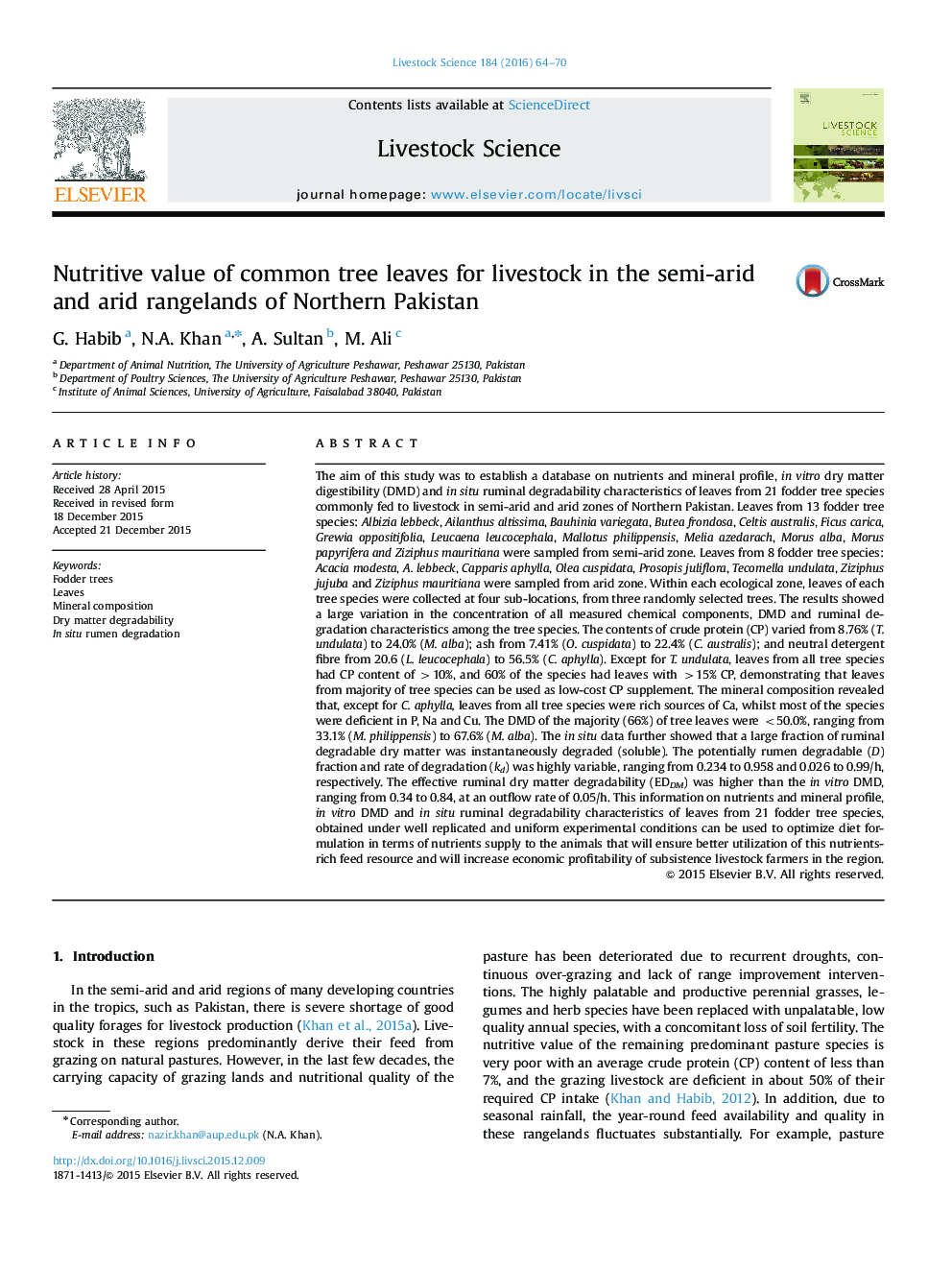| کد مقاله | کد نشریه | سال انتشار | مقاله انگلیسی | نسخه تمام متن |
|---|---|---|---|---|
| 2446975 | 1553948 | 2016 | 7 صفحه PDF | دانلود رایگان |
• Tree leaves can be used as low cost crude protein supplement in the arid areas.
• Tree leaves are good source of Ca for livestock fed on low quality tropical forages.
• Digestibility is an important index for the nutritional value of tree leaves.
The aim of this study was to establish a database on nutrients and mineral profile, in vitro dry matter digestibility (DMD) and in situ ruminal degradability characteristics of leaves from 21 fodder tree species commonly fed to livestock in semi-arid and arid zones of Northern Pakistan. Leaves from 13 fodder tree species: Albizia lebbeck, Ailanthus altissima, Bauhinia variegata, Butea frondosa, Celtis australis, Ficus carica, Grewia oppositifolia, Leucaena leucocephala, Mallotus philippensis, Melia azedarach, Morus alba, Morus papyrifera and Ziziphus mauritiana were sampled from semi-arid zone. Leaves from 8 fodder tree species: Acacia modesta, A. lebbeck, Capparis aphylla, Olea cuspidata, Prosopis juliflora, Tecomella undulata, Ziziphus jujuba and Ziziphus mauritiana were sampled from arid zone. Within each ecological zone, leaves of each tree species were collected at four sub-locations, from three randomly selected trees. The results showed a large variation in the concentration of all measured chemical components, DMD and ruminal degradation characteristics among the tree species. The contents of crude protein (CP) varied from 8.76% (T. undulata) to 24.0% (M. alba); ash from 7.41% (O. cuspidata) to 22.4% (C. australis); and neutral detergent fibre from 20.6 (L. leucocephala) to 56.5% (C. aphylla). Except for T. undulata, leaves from all tree species had CP content of >10%, and 60% of the species had leaves with >15% CP, demonstrating that leaves from majority of tree species can be used as low-cost CP supplement. The mineral composition revealed that, except for C. aphylla, leaves from all tree species were rich sources of Ca, whilst most of the species were deficient in P, Na and Cu. The DMD of the majority (66%) of tree leaves were <50.0%, ranging from 33.1% (M. philippensis) to 67.6% (M. alba). The in situ data further showed that a large fraction of ruminal degradable dry matter was instantaneously degraded (soluble). The potentially rumen degradable (D) fraction and rate of degradation (kd) was highly variable, ranging from 0.234 to 0.958 and 0.026 to 0.99/h, respectively. The effective ruminal dry matter degradability (EDDM) was higher than the in vitro DMD, ranging from 0.34 to 0.84, at an outflow rate of 0.05/h. This information on nutrients and mineral profile, in vitro DMD and in situ ruminal degradability characteristics of leaves from 21 fodder tree species, obtained under well replicated and uniform experimental conditions can be used to optimize diet formulation in terms of nutrients supply to the animals that will ensure better utilization of this nutrients-rich feed resource and will increase economic profitability of subsistence livestock farmers in the region.
Journal: Livestock Science - Volume 184, February 2016, Pages 64–70
